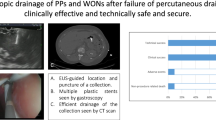Abstract
Background
Endosonography (EUS)-guided transmural pseudocyst drainage is a multistep procedure currently performed with different “off-the-shelf” accessories developed for other applications. Multiple device exchanges over-the-wire is time consuming and risks loss of wire access. This report describes the technical feasibility and outcomes for EUS-guided drainage of pancreatic fluid collections using a novel exchange-free device developed for translumenal therapy.
Methods
Between April and November 2010, 14 patients (9 men; mean age, 49.9 years) with pancreatic fluid collection (mean size, 102 mm) underwent 16 EUS-guided drainage procedures using the exchange-free access device at a single tertiary care center. The trocar of the exchange-free device was used to gain pseudocyst access. The dual-balloon catheter then was advanced over the trocar, followed by inflation of the (first) anchor balloon. Cyst contents were sampled, and contrast was injected to define the pseudocyst anatomy. The first guidewire was inserted into the cyst cavity. The cystenterostomy tract was dilated to 10 mm with the (second) dilation balloon, followed by a second guidewire insertion. The exchange-free access device was removed, leaving the two guidewires in place for two double-pigtail stents.
Results
The procedure was technically successful for all the patients. No acute procedure-related complications occurred. Late complications included a symptomatic leak in a patient who underwent drainage of a pancreatic uncinate pseudocyst from the second duodenum, a self-limited transfusion-dependent bleed after transbulbar drainage, and symptomatic pseudocyst infection.
Conclusion
Pseudocyst access, cystenterostomy tract dilation, and placement of two guidewires for dual stent drainage are technically feasible using an exchange-free access device. The device has the potential to standardize, simplify, and streamline EUS-guided pseudocyst drainage with a single instrument. Comparative studies with alternative tools and methods for pseudocyst drainage are warranted.





Similar content being viewed by others
References
Arvanitakis M, Delhaye M, Bali MA, Matos C, De Maertelaer V, Le Moine O, Deviere J (2007) Pancreatic-fluid collections: a randomized controlled trial regarding stent removal after endoscopic transmural drainage. Gastrointest Endosc 65:609–619
Seewald S, Thonke F, Ang TL, Omar S, Seitz U, Groth S, Zhong Y, Yekebas E, Izbicki J, Soehendra N (2006) One-step, simultaneous double-wire technique facilitates pancreatic pseudocyst and abscess drainage (with videos). Gastrointest Endosc 64:805–808
Reddy DN, Gupta R, Lakhtakia S, Jalal PK, Rao GV (2008) Use of a novel transluminal balloon accessotome in transmural drainage of pancreatic pseudocyst (with video). Gastrointest Endosc 68:362–365
Ahlawat SK, Charabaty-Pishvaian A, Jackson PG, Haddad NG (2006) Single-step EUS-guided pancreatic pseudocyst drainage using a large channel linear array echoendoscope and cystotome: results in 11 patients. JOP 7:616–624
Ang TL, Teo EK, Fock KM (2008) EUS-guided drainage of infected pancreatic pseudocyst: use of a 10F Soehendra dilator to facilitate a double-wire technique for initial transgastric access (with videos). Gastrointest Endosc 68:192–194
Evans JA, Conway JD, Mishra G (2010) A novel method for performing multiple wire insertions during endoscopic cyst gastrostomy. Gastrointest Endosc 71:612–614
Disclosures
Kenneth F. Binmoeller is a consultant (chief medical officer) with an equity interest in Xlumena, Inc. Janak N. Shah is a consultant and advisory board member of Xlumena, Inc. Frank Weilert, Yasser Bhat, and Steve Kane have no conflicts of interest or financial ties to disclose.
Author information
Authors and Affiliations
Corresponding author
Electronic supplementary material
Below is the link to the electronic supplementary material.
Supplementary material 1 (M4V 48416 kb)
Rights and permissions
About this article
Cite this article
Binmoeller, K.F., Weilert, F., Shah, J.N. et al. Endosonography-guided transmural drainage of pancreatic pseudocysts using an exchange-free access device: initial clinical experience. Surg Endosc 27, 1835–1839 (2013). https://doi.org/10.1007/s00464-012-2682-9
Received:
Accepted:
Published:
Issue Date:
DOI: https://doi.org/10.1007/s00464-012-2682-9




